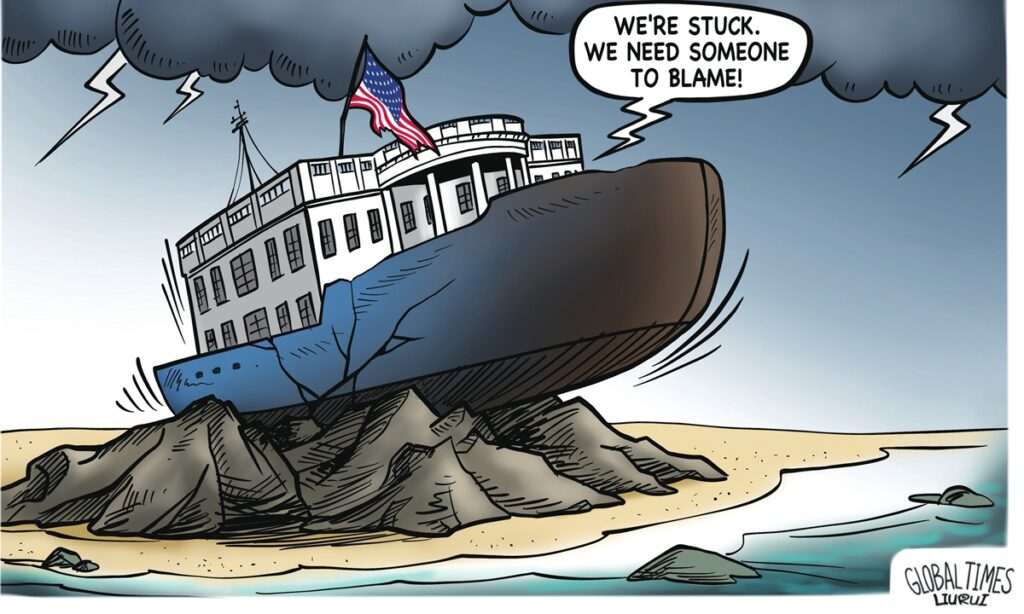The US government appears to believe that cracking down on China’s shipbuilding sector is the cure for its own industry, turning a blind eye to the fact that the decline of the American shipbuilding industry cannot be reversed through protectionism or repression of others.
Following a months-long trade investigation initiated by US Trade Representative Katherine Tai in April 2024 under Section 301, the Biden administration has concluded China uses “unfair policies and practices” to dominate the global maritime, logistics and shipbuilding sectors, Reuters reported on Monday, citing sources familiar with the matter. The results could pave the way for tariffs or port fees on Chinese-built vessels, the report said.
While it is understandable that the success of China’s shipbuilding industry may make some in the US jealous, resorting to measures like the Section 301 investigation will do nothing to alleviate the plight faced by the US shipbuilding industry. According to Clarksons Research’s latest annual review of shipbuilding markets, China consolidated its lead position, taking two-thirds of orders in 2024.
The problems faced by the American shipbuilding industry were not caused by China. The US was relegated to a peripheral role in the global shipbuilding market long before China’s emergence. The decline of America’s shipbuilding industry began in the 1980s, which saw the US shipbuilding industry shed 40,000 jobs, with the collapse of the commercial sector, according to US marine industry media Marine Link.
By the time China accounted for only 2.5 percent of global shipbuilding output way back in 1990, US shipyards had already made their exit, the Cato Institute pointed out.
As an important component of traditional manufacturing, the shipbuilding industry has also been severely affected by the hollowing-out of the American manufacturing sector. That’s the root cause of the problems facing the American shipbuilding sector.
Moreover, the US shipbuilding industry faces high labor costs. Labor costs in the US are significantly higher than in major shipbuilding countries like China and South Korea, and some raw materials and components can only be imported, further increasing costs. The Section 301 investigation can neither change the imbalance in its domestic industrial structure or reduce these costs. On the contrary, it may lead to trade frictions that hinder the import of raw materials or cause prices to rise, further increasing shipbuilding costs.
With countries actively integrating into the global trade and industrial chain, the demand for larger and faster vessels has been on the rise, while China’s shipbuilding industry is well-positioned to effectively meet this demand.
In recent years, with a leading position in international market share and continuously enhanced competitiveness of enterprises, the overall level of China’s shipbuilding industry has been steadily improving. In the first three quarters of 2024, China accounted for 55.1 percent of global ship completions, 74.7 percent of new orders and 61.4 percent of global orders on hand, the People’s Daily reported in October.
From a broader perspective, the vigorous development of China’s manufacturing industry, particularly the rise of its shipbuilding sector, is by no means a coincidence. It is in line with the evolving needs of the global market. From a diverse array of consumer goods that enhance daily living to sophisticated high-end manufactured products that are essential for national development, Chinese goods have gained widespread popularity in the global marketplace, largely due to their exceptional quality and competitive pricing.
Indeed, whether in sectors such as semiconductors or shipbuilding, there exists a tremendous global demand that cannot be overlooked. China has been consistently elevating the quality and technological sophistication of its products in response to this international demand. This relentless pursuit of excellence is the fundamental reason why it is increasingly difficult for the US to impede the advancement of China’s manufacturing sector.
GT




